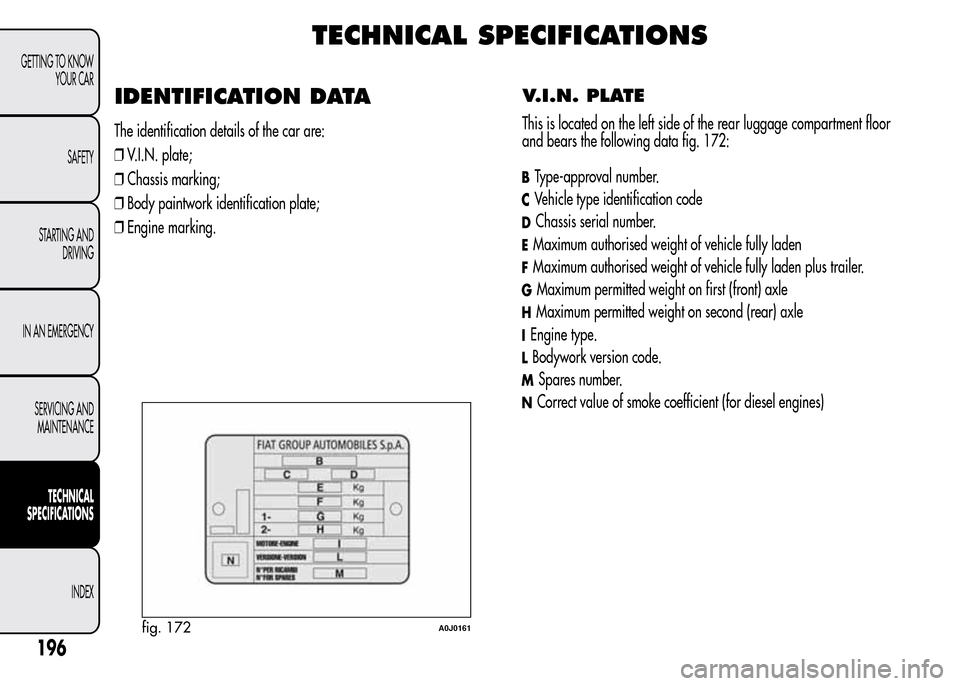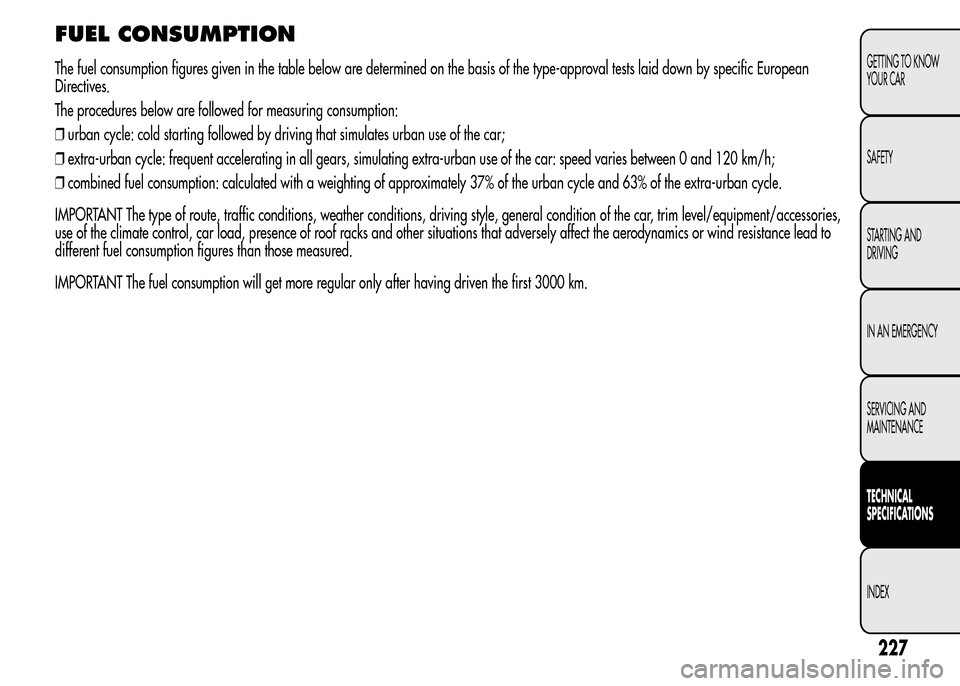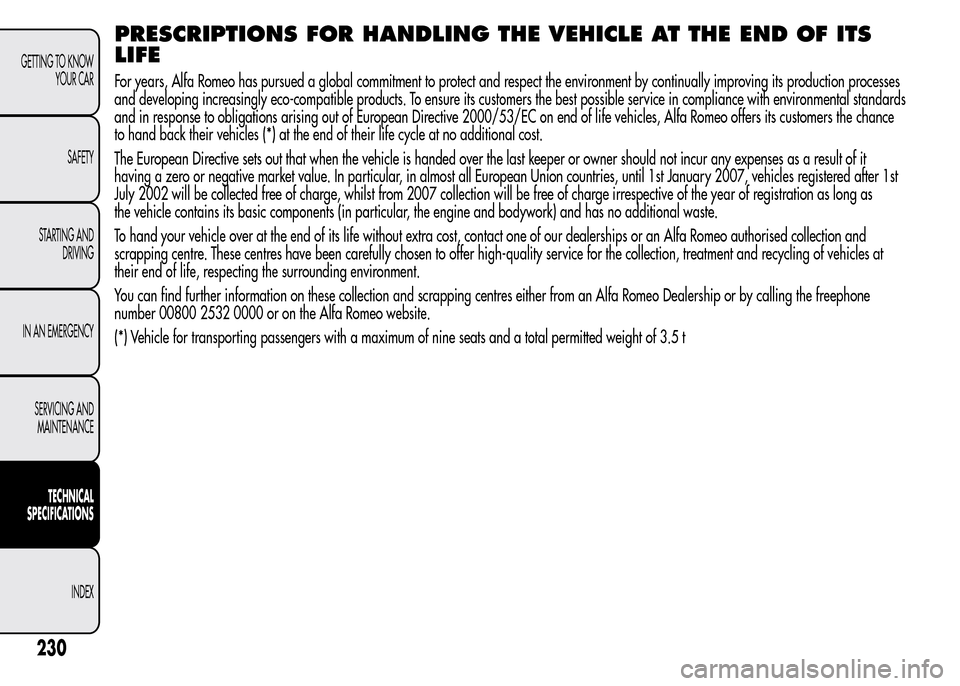2016 Alfa Romeo MiTo weight
[x] Cancel search: weightPage 145 of 280

The vehicle's driving characteristics will be modified
with the space-saver wheel fitted. Avoid violent
acceleration and braking, sharp steering and fast
cornering. The total life of a space-saver wheel is approximately
3,000 km, after which it must be replaced by another wheel of
the same type. Never attempt to fit a conventional tyre on a rim
designed for use as a space-saver wheel. Repair and refit the
standard wheel as soon as possible. Two or more space-saver
wheels should never be used together. Do not grease the threads
of bolts before fitting them: they might slip out.
The jack provided is only intended to be used for
replacing tyres on the vehicle with which it is supplied,
or on same-model vehicles. Never use the jack for
other purposes, such as lifting other car models. Never use it for
repair operations under the vehicle. Incorrect positioning of the
jack may cause the car to fall. Do not use the jack for loads
higher than those shown on the label. Never install snow chains
on the small spare wheel; if a front tyre (driving wheel) is
punctured and you need to use snow chains, use a standard
wheel from the rear axle and install the small spare wheel on the
rear axle. In this way, with two normal front drive wheels, it is
possible to use snow chains.
Incorrectly fitting the hubcap may cause it to fall off
when the vehicle is in motion. Never tamper with the
inflating valve. Never introduce tools of any kind
between rim and tyre. Regularly check the inflation pressure of
the tyres and space-saver wheel (see chapter "Technical
specifications").
JACK
Please note that:
❒the jack weight is 1.76 kg;
❒the jack requires no adjustment;
❒the jack cannot be repaired and in the event of a fault it must be
replaced by another original one;
❒no tool other than its cranking device may be fitted on the jack.
To change a wheel proceed as follows:
❒stop the car in a position that is not dangerous for oncoming traffic
where you can change the wheel safely. The ground must be flat
and sufficiently compact;
❒switch off the engine, pull up the handbrake and engage 1
agear or
reverse; put on the high visibility jacket (required by law) before
leaving the vehicle;
❒open the luggage compartment, pull tab A fig. 116 and lift up the
mat;
fig. 116A0J0104
141
GETTING TO KNOW
YOUR CAR
SAFETY
STARTING AND
DRIVING
IN AN
EMERGENCY
SERVICING AND
MAINTENANCE
TECHNICAL
SPECIFICATIONS
INDEX
Page 200 of 280

TECHNICAL SPECIFICATIONS
IDENTIFICATION DATA
The identification details of the car are:
❒V.I.N. plate;
❒Chassis marking;
❒Body paintwork identification plate;
❒Engine marking.
V.I.N. PLATE
This is located on the left side of the rear luggage compartment floor
and bears the following data fig. 172:
BType-approval number.
CVehicle type identification code
DChassis serial number.
EMaximum authorised weight of vehicle fully laden
FMaximum authorised weight of vehicle fully laden plus trailer.
GMaximum permitted weight on first (front) axle
HMaximum permitted weight on second (rear) axle
IEngine type.
LBodywork version code.
MSpares number.
NCorrect value of smoke coefficient (for diesel engines)
fig. 172A0J0161
196
GETTING TO KNOW
YOUR CAR
SAFETY
STARTING AND
DRIVING
IN AN EMERGENCY
SERVICING AND
MAINTENANCE
TECHNICAL
SPECIFICATIONS
INDEX
Page 222 of 280

WEIGHTS
Weights (kg)Turbo TwinAir 1.4 petrol
4-seater 5-seater 4-seater 5-seater
Unladen weight (with all fluids, fuel tank 90%
full and without optional equipment):1130 1130 1080 1080
Payload including the driver:
(***)480 560 480 560
Maximum permitted loads
(****)
– front axle: 950 950 850 850
– rear axle: 850 850 850 850
– total: 1610 1690 1560 1640
Towable loads
– trailer with brakes: 500 500 500 500
– trailer without brakes: 400 400 400 400
Maximum load on roof: 40 40 40 40
Maximum load on ball (trailer with brakes): 60 60 60 60
(***) If special equipment is fitted (sunroof, tow hitch, etc.) the unladen car weight increases, thus reducing the effective payload with respect tothe maximum permitted
load.
(****) Loads not to be exceeded. The user is responsible for arranging goods in the luggage compartment and/or load platform within the maximum permitted loads.
218
GETTING TO KNOW
YOUR CAR
SAFETY
STARTING AND
DRIVING
IN AN EMERGENCY
SERVICING AND
MAINTENANCE
TECHNICAL
SPECIFICATIONS
INDEX
Page 223 of 280

Weights (kg)1.4 Turbo MultiAir
4-seater 5-seater
Unladen weight (with all fluids, fuel tank 90% full and
without optional equipment):1135 / 1145
(*)1135 / 1145(*)
Payload including the driver:(**)480 560
Maximum permitted loads
(***)
– front axle: 950 950
– rear axle: 850 850
– total: 1625 1705
Towable loads
– trailer with brakes: 500 500
– trailer without brakes: 400 400
Maximum load on roof: 40 40
Maximum load on ball (trailer with brakes): 60 60
(*) 1.4 Turbo MultiAir 170 HP version
(**) If special equipment is fitted (sunroof, tow hitch, etc.) the unladen car weight increases, thus reducing the effective payload with respect to the maximum permitted
load.
(***) Loads not to be exceeded. The user is responsible for arranging goods in the luggage compartment and/or load platform within the maximum permitted loads.
219
GETTING TO KNOW
YOUR CAR
SAFETY
STARTING AND
DRIVING
IN AN EMERGENCY
SERVICING AND
MAINTENANCE
TECHNICAL
SPECIFICATIONS
INDEX
Page 224 of 280

Weights (kg)1.3 JTDM-21.6 JTDM
4-seater 5-seater 4-seater 5-seater
Unladen weight (with all fluids, fuel tank 90%
full and without optional equipment):1150 1150 1205 1205
Payload including the driver:
(*)480 560 480 560
Maximum permitted loads
(**)
– front axle: 950 950 1000 1000
– rear axle: 850 850 850 850
– total: 1630 1710 1685 1765
Towable loads
– trailer with brakes: 1000 1000 1000 1000
– trailer without brakes: 400 400 400 400
Maximum load on roof: 40 40 40 40
Maximum load on ball (trailer with brakes): 60 60 60 60
(*) If special equipment is fitted (sunroof, tow hitch, etc.) the unladen car weight increases, thus reducing the effective payload with respect to the maximum permitted
load.
(**) Loads not to be exceeded. The user is responsible for arranging goods in the luggage compartment and/or load platform within the maximum permitted loads.
220
GETTING TO KNOW
YOUR CAR
SAFETY
STARTING AND
DRIVING
IN AN EMERGENCY
SERVICING AND
MAINTENANCE
TECHNICAL
SPECIFICATIONS
INDEX
Page 231 of 280

FUEL CONSUMPTION
The fuel consumption figures given in the table below are determined on the basis of the type-approval tests laid down by specific European
Directives.
The procedures below are followed for measuring consumption:
❒urban cycle: cold starting followed by driving that simulates urban use of the car;
❒extra-urban cycle: frequent accelerating in all gears, simulating extra-urban use of the car: speed varies between 0 and 120 km/h;
❒combined fuel consumption: calculated with a weighting of approximately 37% of the urban cycle and 63% of the extra-urban cycle.
IMPORTANT The type of route, traffic conditions, weather conditions, driving style, general condition of the car, trim level/equipment/accessories,
use of the climate control, car load, presence of roof racks and other situations that adversely affect the aerodynamics or wind resistance lead to
different fuel consumption figures than those measured.
IMPORTANT The fuel consumption will get more regular only after having driven the first 3000 km.
227
GETTING TO KNOW
YOUR CAR
SAFETY
STARTING AND
DRIVING
IN AN EMERGENCY
SERVICING AND
MAINTENANCE
TECHNICAL
SPECIFICATIONS
INDEX
Page 234 of 280

PRESCRIPTIONS FOR HANDLING THE VEHICLE AT THE END OF ITS
LIFE
For years, Alfa Romeo has pursued a global commitment to protect and respect the environment by continually improving its production processes
and developing increasingly eco-compatible products. To ensure its customers the best possible service in compliance with environmental standards
and in response to obligations arising out of European Directive 2000/53/EC on end of life vehicles, Alfa Romeo offers its customers the chance
to hand back their vehicles (*) at the end of their life cycle at no additional cost.
The European Directive sets out that when the vehicle is handed over the last keeper or owner should not incur any expenses as a result of it
having a zero or negative market value. In particular, in almost all European Union countries, until 1st January 2007, vehicles registered after 1st
July 2002 will be collected free of charge, whilst from 2007 collection will be free of charge irrespective of the year of registration as long as
the vehicle contains its basic components (in particular, the engine and bodywork) and has no additional waste.
To hand your vehicle over at the end of its life without extra cost, contact one of our dealerships or an Alfa Romeo authorised collection and
scrapping centre. These centres have been carefully chosen to offer high-quality service for the collection, treatment and recycling of vehicles at
their end of life, respecting the surrounding environment.
You can find further information on these collection and scrapping centres either from an Alfa Romeo Dealership or by calling the freephone
number 00800 2532 0000 or on the Alfa Romeo website.
(*) Vehicle for transporting passengers with a maximum of nine seats and a total permitted weight of 3.5 t
230
GETTING TO KNOW
YOUR CAR
SAFETY
STARTING AND
DRIVING
IN AN EMERGENCY
SERVICING AND
MAINTENANCE
TECHNICAL
SPECIFICATIONS
INDEX
Page 276 of 280

– Luggage compartment roof light ....... 68
– Puddle lights ................................... 68
Roof rack/ski rack ................................ 86
Safe Lock device ................................. 37
Saving fuel .......................................... 135
SBR system (Seat Belt Reminder) ............ 110
Scheduled servicing.............................. 171
Scheduled Servicing Plan ...................... 172
Seat belts............................................. 109
– Use ................................................ 109
Seats ................................................... 43
– Easy Entry ...................................... 44
– Front seats ...................................... 43
– Sports configuration front seats......... 44
Setup menu ......................................... 23
Side airbags (Side Bags - Window
Bags) ................................................ 126
Side bags (front side airbags) ............... 127
Side lights/brake lights ......................... 156
Side lights/daytime running lights
(DRL)
– bulb replacement............................. 154
Side lights/dipped beam headlights ...... 60
“Smart Bag” system (Multistage front
airbags) ............................................ 123
Snow chains....................................... 138
Snow tyres ........................................... 137
Spark plugs (type) ................................ 200
Speedometer (speed indicator) .............. 6
Starting the engine ............................... 130
Starting the engine ............................... 139
– Bump starting.................................. 140
– Jump starting .................................. 139
Start&Stop system ................................ 95
Steering lock ........................................ 42
Steering system .................................... 208
Steering wheel ..................................... 46
Storing the car ..................................... 138
Sun visors ............................................ 73
Suspension .......................................... 207
Symbols .............................................. 33
Technical specifications ....................... 196
The keys .............................................. 35
– Code Card...................................... 35
– Key without remote control ............... 35
– Key with remote control.................... 35
Third brake lights
– bulb replacement............................. 157
Towing the car ..................................... 169
– Attaching the tow hook .................... 169Towing trailers ..................................... 136
– Installing a tow hook........................ 137
TPMS (Tyre Pressure Monitoring
System) ............................................. 104
Transmission ........................................ 206
TRIP button .......................................... 32
Trip Computer ...................................... 30
Ty r e s
– correct tyre reading ......................... 209
– Fix&Go Automatic (kit) .................... 146
– inflation pressure ............................. 214
– snow tyres ...................................... 212
– tyres provided ................................. 212
Tyres - maintenance .............................. 188
Using the Gearbox ............................. 133
Warning lights on panel .................... 6
Weights............................................... 218
Welcome movement ............................. 22
Wheel rims
– correct reading of the rim code ......... 211
– dimensions ..................................... 212
– wheels and tyres.............................. 188
272
GETTING TO KNOW
YOUR CAR
SAFETY
STARTING AND
DRIVING
IN AN EMERGENCY
SERVICING AND
MAINTENANCE
TECHNICAL
SPECIFICATIONS
INDEX